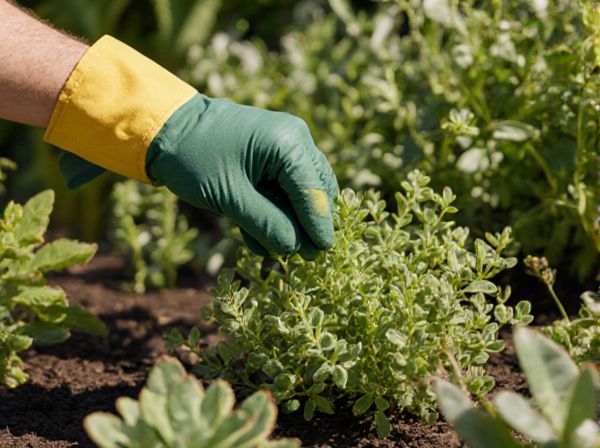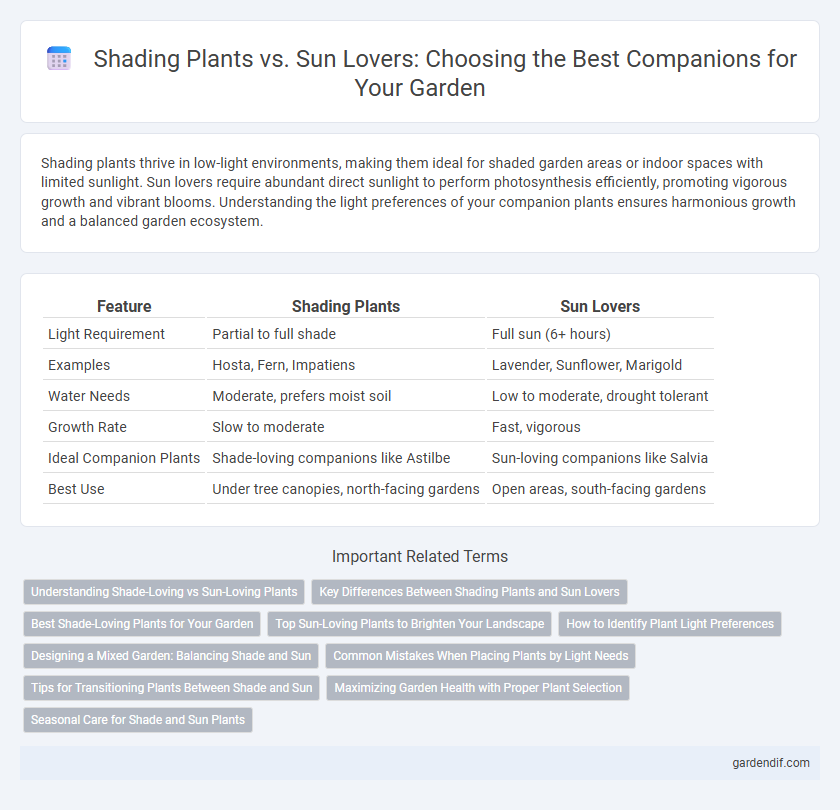
Shading plants vs sun lovers Illustration
Shading plants thrive in low-light environments, making them ideal for shaded garden areas or indoor spaces with limited sunlight. Sun lovers require abundant direct sunlight to perform photosynthesis efficiently, promoting vigorous growth and vibrant blooms. Understanding the light preferences of your companion plants ensures harmonious growth and a balanced garden ecosystem.
Table of Comparison
| Feature | Shading Plants | Sun Lovers |
|---|---|---|
| Light Requirement | Partial to full shade | Full sun (6+ hours) |
| Examples | Hosta, Fern, Impatiens | Lavender, Sunflower, Marigold |
| Water Needs | Moderate, prefers moist soil | Low to moderate, drought tolerant |
| Growth Rate | Slow to moderate | Fast, vigorous |
| Ideal Companion Plants | Shade-loving companions like Astilbe | Sun-loving companions like Salvia |
| Best Use | Under tree canopies, north-facing gardens | Open areas, south-facing gardens |
Understanding Shade-Loving vs Sun-Loving Plants
Shade-loving plants thrive in low-light environments by adapting to indirect sunlight, often requiring less water and cooler conditions compared to sun-loving plants. Sun-loving plants need direct sunlight for photosynthesis, typically growing more vigorously in open, bright areas and demanding higher water and nutrient levels. Understanding these growth preferences helps gardeners select companion plants that optimize space, reduce competition, and promote a healthier garden ecosystem.
Key Differences Between Shading Plants and Sun Lovers
Shading plants thrive in low-light conditions, preferring indirect sunlight and cooler temperatures, while sun lovers require direct sunlight for at least six hours daily to perform photosynthesis effectively. Shading plants often have larger, thinner leaves to maximize light absorption in dim environments, whereas sun lovers possess smaller, thicker leaves with protective coatings to minimize water loss under intense solar exposure. Understanding these adaptations helps gardeners optimize plant placement for healthy growth and improved companion planting outcomes.
Best Shade-Loving Plants for Your Garden
Shade-loving plants such as hostas, ferns, and astilbes thrive in low-light environments and enhance garden corners with lush foliage and vibrant, delicate blooms. These plants require well-drained, moist soil and can reduce weed growth by creating dense ground cover. Choosing shade-tolerant companions benefits soil health by retaining moisture and supporting beneficial insect habitats.
Top Sun-Loving Plants to Brighten Your Landscape
Top sun-loving plants such as lavender, blanket flower, and salvia thrive in full sun, bringing vibrant color and texture to your landscape. These drought-tolerant plants require at least six to eight hours of direct sunlight daily to maintain optimum growth and flower production. Incorporating sun lovers alongside shading plants like hostas or ferns creates a balanced garden ecosystem that maximizes visual appeal and plant health.
How to Identify Plant Light Preferences
Shading plants thrive in indirect, filtered sunlight, often showing darker, broader leaves adapted to low-light environments, while sun lovers prefer bright, direct light with smaller, thicker leaves suited for intense sun exposure. To identify plant light preferences, observe natural habitats, leaf coloration, and growth patterns: shade-tolerant species typically grow on forest floors, whereas sun-loving plants dominate open fields. Testing light sensitivity by gradually increasing exposure helps determine optimal conditions for companion planting arrangements, enhancing plant health and yield.
Designing a Mixed Garden: Balancing Shade and Sun
Designing a mixed garden requires selecting companion plants that thrive in varying light conditions, balancing shade-tolerant species like hostas and ferns with sun-loving plants such as lavender and coneflowers. Incorporate shrubs or small trees strategically to create natural shade zones that protect delicate plants while allowing sun lovers to flourish in open areas. Thoughtful layering and plant placement optimize growth, biodiversity, and visual interest in gardens combining shaded and sunny environments.
Common Mistakes When Placing Plants by Light Needs
Placing shade-loving plants like ferns or hostas in direct sunlight can cause leaf scorching and stunted growth, while sun-loving plants such as lavender or tomatoes will suffer from poor development and reduced flowering when kept in overly shaded areas. Misjudging the specific light intensity and duration required for each plant often leads to imbalanced photosynthesis and weakened health. Ensuring proper placement based on precise light preferences optimizes growth patterns, nutrient absorption, and overall plant vitality in companion gardening.
Tips for Transitioning Plants Between Shade and Sun
Transitioning plants between shade and sun requires gradual exposure to prevent stress and sunburn, starting with partial sunlight and increasing duration over one to two weeks. Monitoring plant health during this acclimation period helps identify signs of heat stress or etiolated growth, enabling timely adjustments in watering and placement. Selecting species with moderate sun tolerance and implementing mulch can further protect roots and maintain soil moisture during the transition.
Maximizing Garden Health with Proper Plant Selection
Shading plants such as ferns and hostas thrive in low-light areas, improving soil moisture retention and reducing weed growth, while sun lovers like tomatoes and marigolds boost photosynthesis and nutrient uptake in brighter zones. Selecting companion plants based on their light preferences ensures balanced microclimates, enhancing overall garden health and productivity. Proper placement of shade-tolerant and sun-loving species optimizes resource use, supports beneficial insect habitats, and minimizes plant stress.
Seasonal Care for Shade and Sun Plants
Shade plants require consistent moisture and protection from harsh afternoon sun, flourishing in cool, humus-rich soil with periodic mulching to retain hydration. Sun-loving plants thrive with full sunlight exposure, needing well-drained soil and regular feeding during peak growing seasons to support vigorous blooms. Seasonal care for both includes monitoring temperature fluctuations, adjusting watering schedules, and pruning to encourage healthy growth and prevent stress-related damage.
Shading plants vs sun lovers Infographic

 gardendif.com
gardendif.com